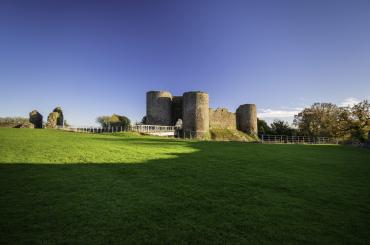Skenfrith Castle
Visitor Notice
Please be aware, overnight parking or camping is not permitted on Skenfrith Castle grounds at any time.
Significant medieval fortress with a substantial central tower
One of the ‘Three Castles of Gwent’ (along with Grosmont and White Castle) founded by Norman lord William fitz Osbern in the early 12th century, the remains of Skenfrith we see today are of a later fortress constructed in the 13th century by Hubert de Burgh. The castle’s well-preserved walls surround a circular keep, similar to those seen at Bronllys and Tretower. Built on an earthen mound, this sturdy structure was a last line of defence should the castle fall under attack.
Between them, the Three Castles controlled a large area of confrontational border country between the River Wye and the Black Mountains, with Skenfrith occupying a strategic spot on the banks of the River Monnow overlooking one of the main routes between Wales and England.
Opening times & prices
Opening times
| 1st April - 31st March | Open all year |
|---|---|
|
Open all year — during reasonable daylight hours |
|
Visitor information
Bikes access
Bike storage area available in car park or close to site.
Car park
There is a small area for parking that will accommodate approx. 6 cars in front of the castle.
There is no dedicated disabled parking.
Please be aware, overnight parking or camping is not permitted on Skenfrith Castle grounds at any time.
Dogs welcome
Dogs on short leads welcome to access ground floor levels of the site.
Walking difficulty
Terrain: Level 2 – Easy
Drone policy
Please read our policy information about flying drones at Cadw monuments: read the guidance
No smoking
Smoking is not permitted.
Health & Safety
Situated next to the river Monnow, part of this site is regularly exposed to river overflow from high tide and run off.
This results in a build-up of river debris and silt which can cause part of the site adjacent to the river to be slippery. We do not encourage swimming here. National Resources Wales are responsible for the river and its upkeep.
Sets of historic steps are required to access some parts of the site, we ask that you take care as they are uneven in sections. Please use handrails where provided.
As with all ancient monuments there is always a risk of stones being dislodged in bad weather, however, we manage this through extensive monitoring.
Climbing may result in serious injury.
There are several wild plants and flowers, although these are great pollinators, they may be poisonous to visitors and animals, we strongly advise you not to touch or allow dogs to eat any vegetation.
Please watch our health & safety film before visiting Cadw sites.
Iechyd a Diogelwch / Health and Safety
Please report any anti-social behaviour such as climbing, setting fires, graffiti etc. to CadwAccidentsReports@gov.wales
The following signs can be found around the site at key areas of risk, please pay attention where appropriate.
Deep water
Slippery or uneven surfaces
Steep and uneven steps
Falls from height
Falling masonry
Directions
Google Mapwhat3words: ///cooking.exams.handlebar
Unlimited access to Wales' past
Join Cadw for as little as £2.00 a month and gain unlimited access to over 100 historical sites.
Enjoy the many benefits of Cadw membership
- 10% off Cadw gift shops
- 50% off entry to English Heritage and Historic Scotland sites
- FREE entry to English Heritage and Historic Scotland on renewal
- FREE entry to Manx National Heritage properties
- FREE membership pack including car sticker and full colour map
